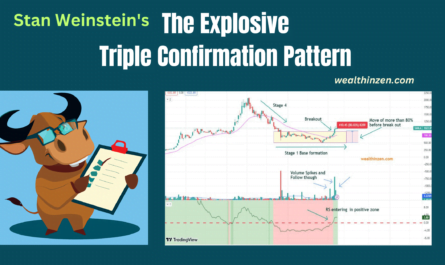When it comes to managing risk in the stock market the most common word one would hear from the experienced players is “ Maintaining Proper Risk Reward Ratio”. The usual ratio that is touted in most articles or videos is 1:2 risk reward ratio. However, do you really think that just maintaining a 1:2 risk reward ratio is enough to win this trading game where the sharks are ready to devour small fishes like us?
I did some simple math using the risk reward ratios in multiple practical scenarios and found some interesting facts which I will be discussing in this article. Kindly read the article to the full and re read if you want to understand the concept thoroughly.
Risk reward ratio:
Before moving into the topic just a small brush up for beginners about risk reward.
Risk-reward ratio is a term used in trading that represents the relationship between the potential profit of a trade and the potential loss. It is a measure of the amount of risk taken on a trade relative to the potential reward. In general, the risk-reward ratio is calculated by dividing the amount of profit that a trader expects to make on a trade by the amount of potential loss if the trade goes against them.
For example, let’s say a trader buys a stock at 100 rupees with a stop loss at 90 and a profit target at 120. In this case, the potential profit is 20, and the potential loss is 10. The risk-reward ratio would be 2:1, meaning that the potential profit is twice as large as the potential loss.
Risk reward and the coin theory:
If you had read some good trading books, you would have been now familiar with the coin flip theory. The coin flip theory suggests that if a trader were to flip a coin and bet on heads or tails, they would have a 50/50 chance of winning or losing. If the trader were to risk $1 on each flip, they would expect to win $1 half the time and lose $1 half the time, resulting in a net gain of zero.
However, if the trader were to risk $1 on each flip but aim for a reward of $2 (i.e., a 2:1 risk-reward ratio), they would only need to win 33% of the time to break even. This is because when they win, they win $2, but when they lose, they only lose $1. Therefore, even if they only win one out of every three trades, they would still come out ahead in the long run.
Though this theory is right it’s very rudimentary when it comes to trading. Because live trading with real money is different from theory. Let us see why?
Winning Percentage and Risk Reward ratio:
Now, let us assume an example of a trader with an account size of 100,000. For each trade he sets a stop loss of 1% (1000 INR) and a Target of 2% (2000 INR). This brings the risk reward ratio to 2:1.
So, as per our coin theory let us assume that the trader loses five trades and gains a profit in five trades.
So, the winning probability is 50:50, that is he wins 50% of time and loses 50% of time.
See the image below to see how the trades went:
The trader ends up with a profit of 5%.
Also, note that in the above trades, after each trade the risk taken is adjusted according to the capital available. In trade 1 the trader loses 1000 (1%) and so in trade 2 he risks only 1% of remaining capital that is 99000. So he risks only 990 in the second trade and so on. This type of percentage based position sizing is superior to risking a fixed amount every trade. I had written a detailed article on “Why percentage based position sizing is the best”?
Now, let us take another scenario, where the trader takes similar trades, but this time he wins only 30% of the time. It means he loses 7 trades out of 10 and wins only three.
See the table below:
Now, you can see that with the same risk reward ratio, he gets a net loss of -1.09%, while he got 5% net gain when his winning percent was 50%.
Similarly, if the winning % is just 20% then with same risk reward ratio, he will end up as shown below:
Now, you can see that the trader ends up with different outcomes depending on his winning percentage.
So, one has to be clear that there is randomness in the outcome depending upon the winning percentage.
Winning Percentage and the Risk Reward connection:
So, if our strategy wins only 30% of time, should we abandon the strategy? No. There are some great traders whose system gives them only 30% right signals and yet wins big. What do they do? Simple. They just change their risk reward ratio, also interpreted as R Multiple.
R multiple is nothing but the profit percentage you gain for the risk you have taken. It is calculated by dividing the profit at the exit of the position by the initial risk taken during the entry of that position.
For example, if your risk is 1000 at the time of entry and your profit is 2000 then the R Multiple is calculated by 2000 /1000 = 2. Hence, R multiple is 2R.
Similarly, if your risk is 1000 and you end up with a profit of 3000 then R multiple is 3000 / 1000 = 3. Thus, the R multiple is 3R. Tracking R multiple and journaling it will make you a better trader.
Hence, if our winning strategy is only 30% and we need a gain, we need at least an R Multiple of 3. That is you need to win three times your risk if your winning % is only 30%.
Similarly if our winning strategy is only 20% then to end up in positive gain we need an R Multiple of 5.
See the table below:
Even though the trader lost eight trades, he could still end up in profit provided, he gets an R multiple of 5. That is 5R. See the trades marked in the red rectangle.
Consistent Risk and Reward %:
The success of a trader depends on how effectively he reduces the randomness.
See the table below:
In the above table you can see that though the trader takes 1:2 risk reward types of trades, the risk % and the reward % varies for each trade. In trade 1 risk is just 3% and in second trade it is 4%.
As a result of this randomness the outcome is very different and inconsistent (See red arrows).
Inconsistency often leads to confusion and will sabotage your trading journey. So, next time when you trade make sure you have a more consistent risk and reward %. If you risk 2% per trade try looking for trades that fulfill the criteria. Make the risk % in a range. Don’t make it too random like, in one trade you risk 5% and in net you risk 12%.
You can use my free position sizing calculator for calculating how much shares to buy depending on the risk you are willing to take.
Don’t jump on random trades and make your trading life miserable. Be patient to get the right opportunity. Never fall into the trap of FOMO. (Fear of missing out).
Key takeaways:
- Risk reward ratio as a single entity is not that useful for a trader in real life situations.
- Adjusting the risk reward ratio based on your winning percentage will help greatly.
- You can end up in profit even if you win only 30% of time if you maintain a proper R Multiple.You can use this excel link to track your trades and R Multiple.
- Reduce randomness as much as possible.
- Always maintain your risk % and reward % to be the same as much as possible for each trade.
- Track everything, tracking is an essential part of your trading journey. Don’t underestimate this.
If you like my article you can consider subscribing to my newsletters. Happy Trading !!!




4 thoughts on “The untold secrets of Risk Reward Ratio in trading (Do this if you want to win consistently)”